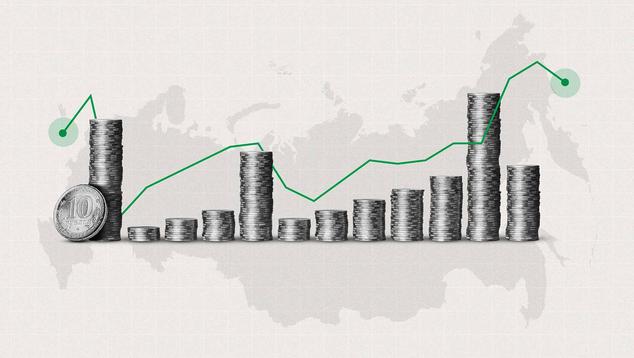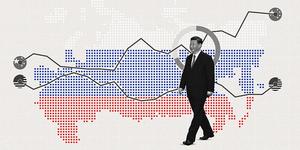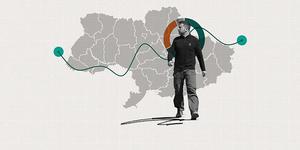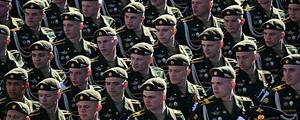LONDON — More than three years after Russia’s full-scale invasion of Ukraine, the country’s economy has weathered sanctions better than many observers expected. Gallup’s latest survey of Russia in 2025 reflects this resilience but also shows a growing strain in how Russians view their local economies.
Since 2022, more Russians have said their local economy is getting better rather than getting worse, but this gap has narrowed to just nine percentage points in 2025. The proportion who say things are getting better has dipped to 48% (from a 2023 high of 56%), while 39% now say things are getting worse.
The first two years of the COVID-19 pandemic are the only ones on record when more Russians than in 2025 reported that their economy was getting worse.
After an initial contraction in 2022, Russia’s economy staged a sharp rebound, posting reported growth of more than 4% in both 2023 and 2024. Several factors underpinned this performance: the accumulation of substantial foreign exchange reserves during the previous decade, the slow rollout of Western sanctions that gave Russia time to adapt, and a rapid shift to a war economy that redirected production toward military needs.
But looking ahead, growth is forecast to slow sharply over the course of 2025. Inflation has remained stubbornly high, exceeding 8% — more than twice the Central Bank’s target — while the defense sector continues to absorb a large share of the workforce and government revenues. Russia’s economy minister admitted in June that the economy is in a state of “overheating.”
Russians Divided on Job Opportunities
In 2025, Russians are almost evenly split in their views toward job availability, with 49% saying it is a good time to find a job, while 46% say it is a bad time. Perceptions of the local job market rallied in 2023, after being negative since 2009 following the global financial crisis.
For much of the past two decades, Russians’ views of the job market have broadly tracked the unemployment rate. That rate recently fell to a record post-Soviet low. Before the invasion, unemployment was already low, with most skilled workers having jobs. But since late 2022, rising demand — combined with the loss of around a million working-age men through mobilization — has tightened the labor market further, driving unemployment down and increasing competition for skilled workers.
This tightening has created conditions where the risk of unemployment is low, but many industries report labor shortages, and wages have risen as employers compete for talent.
Feelings About Household Incomes Remain Resilient
Russian wage growth hit a 16-year high in 2025, driven by labor shortages, mass mobilization, payouts to soldiers and their families, and unprecedented state spending on defense. Against this backdrop, Russians feel more positively about their household incomes today than they did before the war. Two in five (39%) currently say they are living comfortably on their incomes, well exceeding the 22% who report finding things difficult or very difficult.
This marks a sharp change from 2021, the year before the invasion, when 27% were living comfortably and nearly one in three (32%) said they were struggling.
Although the war economy has likely improved many households’ financial standing — at least in the short term — many economists do not expect this rapid growth in real incomes to last. As the economy slows, there are signs of weaker wage growth in 2025, after the boom of 2023 and 2024.
Almost One in Three Struggle to Afford Food
Despite low unemployment and higher salaries, long-standing vulnerabilities persist in the Russian economy. In 2025, 31% of Russians say they have struggled to afford food for themselves and their families in the past year. This figure is in line with the average since 2022 but significantly higher than a decade ago, when fewer Russians reported such hardship.
Food inflation has outpaced overall inflation in Russia, and the price of potatoes — an essential item for poorer households — has risen by 167% since 2024 as crop harvests have fallen.
Grain exports, which have largely avoided Western sanctions, have remained one of Russia’s few reliable sources of international leverage since the war began. But the poor harvest in 2025 is threatening this advantage at a time when nearly one in three Russians are already struggling to feed their families. The contrast of record-low unemployment alongside persistent difficulty in affording food highlights the uneven nature of Russia’s economic resilience.
Poorest Russians Feel Different From Richest About the Economy
Even though public opinion toward the economy, jobs and incomes remains more positive than before the war, these sentiments are far from evenly felt across Russian society. Larger household incomes are strongly related to greater optimism about living standards, job opportunities and household finances.
While Gallup often finds greater economic optimism among higher-earning households, the divides in Russian attitudes between rich and poor are particularly sharp. Among the poorest 60% of Russians, only about one in four say they are living comfortably on their present incomes. Among the richest 20%, that figure jumps to two in three (66%).
Similarly, struggles to afford food are much more prevalent among lower-income households, while wealthier Russians remain more insulated from this pressure. The poorest 20% are roughly twice as likely as other income brackets to say the economy is the biggest problem facing Russia. These divides underscore how resilience at the national level can mask significant inequality at the individual level.
Bottom Line
Russia’s economy has proved more durable than expected in the years since the invasion of Ukraine, but signs of strain are mounting in 2025. Record-low unemployment and high wage growth have coincided with Russians expressing more-positive views of jobs and incomes, but high inflation, food unaffordability and persistent inequality highlight deeper vulnerabilities. The combination of these forces points to both the resilience and fragility shaping Russia’s economic future.
Stay up to date with the latest insights by following @Gallup on X and on Instagram.
For complete methodology and specific survey dates, please review Gallup's Country Data Set details. Learn more about how the Gallup World Poll works.




